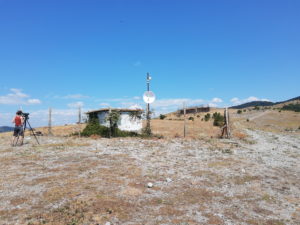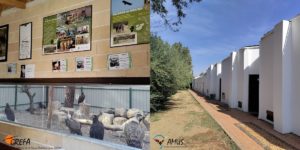The role of wildlife rehabilitation and breeding centres in species reintroduction programmes
Outdoor adaptation aviary located in the “Sinite Kamani” Nature Park, Bulgaria, with vultures translocated from Spain
Every year, the Alfred Toepfer Natural Heritage Scholarship supports the work of young conservationists in Protected Areas across Europe. Réka Szilágyi, was one of the winners of the Scholarship in 2020 and travelled to Bulgaria and Spain to learn more about the role of wildlife rehabilitation and breeding centres in vulture reintroduction programmes. The following article is written by Réka . The current call for scholarships is also opened
Reka works as IT professional at Milvus Group Bird and Nature Protection Association (Targu Mures, Romania) and provides assistance at the Milvus Group’s Wildlife Rehabilitation Center.
Global biodiversity is facing an unprecedented crisis, mainly due to the accelerating loss of natural habitats, biological invasions and global climate change. One of the active conservation measures which can be applied to mitigate biodiversity loss is the international translocation of endangered species through reinforcement and reintroduction programmes. These initiatives aim to artificially increase an existing but declining population (reinforcement) or to re-establish an extinct population (reintroduction). Both are carried out by the translocation of wild or captive-bred individuals inside their natural distribution range. These measures require the joint effort of several institutions and organizations, such as wildlife rehabilitation centres, National Parks and local authorities.
Watch Réka’s video summary!
With the support of the Alfred Toepfer Natural Heritage Scholarship I studied the role of wildlife rehabilitation and breeding centres in the reinforcement and reintroduction of four endangered European vulture species. I especially focussed on the collaboration between the rehabilitation and breeding centres and the entities responsible for the management of Protected Areas where these vulture populations live. On my study tour I visited three wildlife rehabilitation and breeding centres, one in Bulgaria and two in Spain: the Green Balkans Wildlife Rehabilitation and Breeding Center (Bulgaria), the AMUS Wild Fauna Hospital and the GREFA Wildlife Hospital and Breeding Center (Spain). I also visited the “Sinite Kamani” Nature Park in Bulgaria, and the Sierra Grande de Hornachos SPA and the Valle de Iruelas Nature Reserve in Spain.

Réka during her study trip
The three wildlife rehabilitation and breeding centres have a wide range of activities. Besides participating in different reintroduction programmes by captive breeding of endangered species, they shelter illegally traded and confiscated animals and provide veterinary care and rehabilitation to wild individuals. Some of the centres are also open to the public and therefore have an important role in environmental education. They are visited annually by thousands of children and adults, who can gain valuable knowledge about the species of the local fauna, and can learn about the human impact on wildlife and the challenges faced by wildlife conservation.
The visited wildlife rehabilitation and breeding centres are actively involved in vulture reinforcement and reintroduction programmes as well. The processes of reinforcement and reintroduction involve several techniques to increase/re-establish the target population. One of the methods is the captive breeding of individuals and their release into the wild. The most successful method to release captive bred individuals is called “hacking”. During hacking, chicks are placed in artificial nests, located in their release site, and are fed with minimal human contact until they become independent. Another method for reintroduction is the translocation of wild subadult or adult individuals from a source population. In this latter case the translocated birds are usually specimen found in distress in the wild, and which have been treated in the rehabilitation and breeding centres. Following their full recovery, the individuals are transported to the target country. Once arrived at the translocation site, birds spend several months in specially designed outdoor adaptation aviaries until they become familiar with their new environment, after which they finally get released into the wild.
The entities managing the Protected Areas where rehabilitated birds are being released have an important role in the success of reinforcement/reintroduction programmes.
A strong collaboration between the rehabilitation and breeding centres and Protected Area management is essential.
The involvement of the Protected Areas management can improve the visibility of the programmes by reaching the visitors directly, on site, through information panels, leaflets, mobile applications, or educational activities. Protected Area management might also have a more active collaboration with the local communities, thus they can play an important role in the propagation of the programme among the local stakeholders, ultimately improving the social acceptance of the initiative. The rangers or the field specialists frequently collaborating with the area’s management, have a wide knowledge about the fine-scale characteristics of the area. Hence, their experience could help in the evaluation and elimination of potential threats which reintroduced individuals face after their release, such as electrocution, poaching or poisoning.

Vultures in the visitor area of the GREFA Wildlife Hospital and Breeding Center (left) and the Rehabilitation area at the AMUS Wild Fauna Hospital (right)
During my study tour I gained valuable knowledge on the role of wildlife rehabilitation and breeding centres and Protected Areas’ management in reinforcement/reintroduction programmes. The best practices I learnt about can provide guidance for designing and implementing vulture reintroduction programmes in Romania. The gathered information can be useful also for international specialists interested in wildlife rehabilitation or vulture reintroduction, and for entities managing Protected Areas, in order to increase and diversify their efforts invested in similar initiatives.
Do you want to get to know Réka better? She will present her work at the EUROPARC Conference in Austria. Last year, we’ve also asked her some questions about her study trip in our EUROPARC Podcast:
Application to the Alfred Toepfer Scholarship 2022 are currently opened. Apply until the 29th of April!